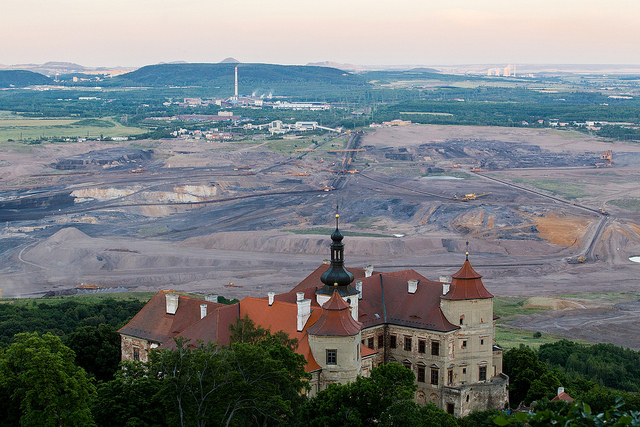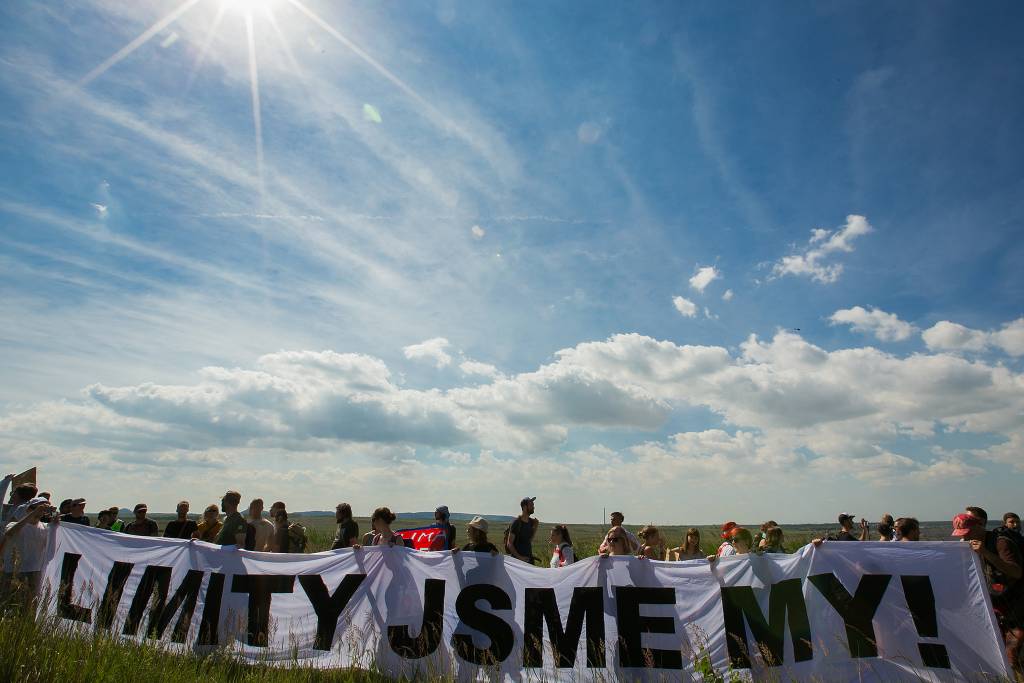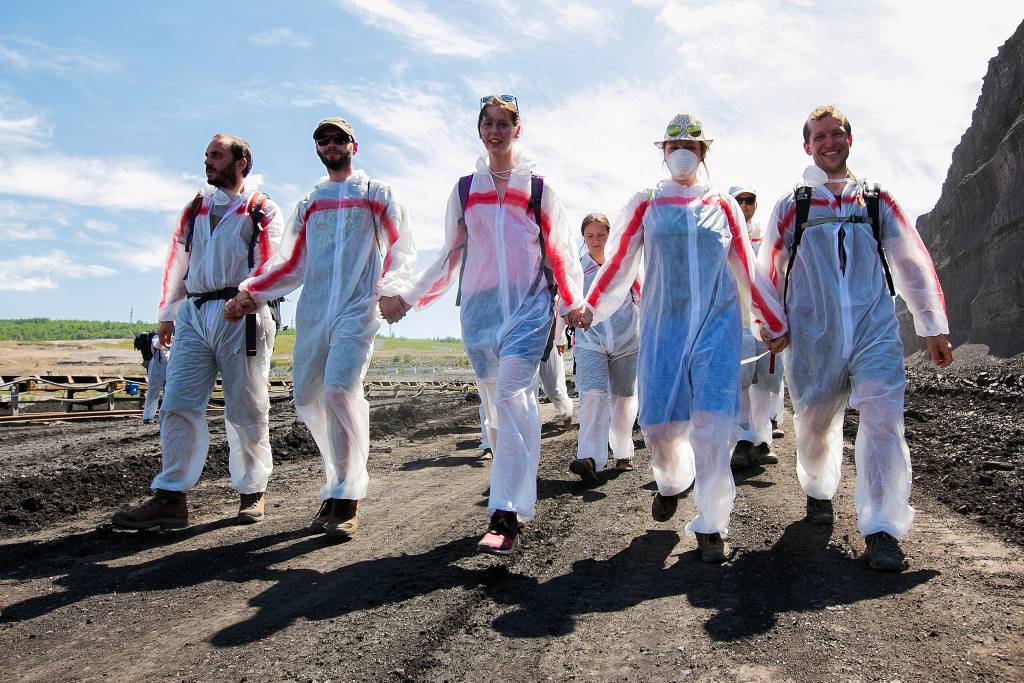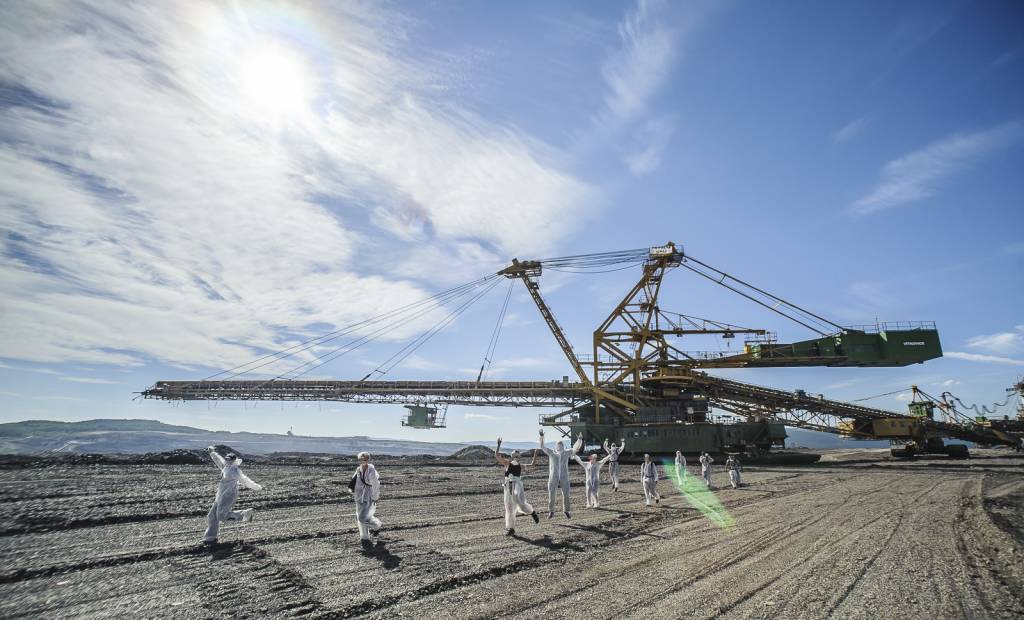Guest blog by Radek Kubala, Josef Patočka and Antonie Bernardová
Libkovice could have been a very pleasant place to live. Lying along a stream on the foothills of the majestic ore mountains that separate Czech Bohemia from German Saxony, the village used to be home to several hundreds of people. It had its own bakery, a typical country-side inn and reportedly quite a strong communal spirit. Regrettably, Libkovice is no more. It has followed the fate of dozens of other towns and villages in the North-Bohemian basin, destroyed to give way to giant open-cast lignite pits.
The people of Libkovice were the last to go. The town was razed to ground in the years 1992 – 1993 despite fierce resistance by the local community and the nascent environmental movement. It was a wake-up call to the reality that the new democratic conditions were not going to make everything perfect. They and their town remain a symbol of the toll that the coal industry takes on the environment and its people.

Destruction of open pit mining in the Czech Republic. Photo: Majda Slámová/ Limity jsme my
Today, just a few minutes’ walk from where Libkovice once stood, a new generation of climate justice activists is organising the anti-coal “Klimakemp,” now in its second year. They are taking on the fact that despite this painful history, the Czech Republic (together with Germany and Poland) remains one of the coal power-houses of Europe.
The Czech government plans to continue mining and burning this climate-wrecking fuel into the second half of this century. More than half of the country’s electricity comes from coal. Because of this, the Czech Republic remains one of the largest CO2 emitters in the European Union in terms of per capita emissions, sharing its fourth place ranking with the Netherlands. Despite also being one of the largest net-exporters of electricity on the continent, it continues to run a dozen of old, obsolete power plants from the ’70s and ’80s. Their annual production corresponds almost precisely to the amount of electricity exported each year.
In 2015, as the world was gearing up for the UN climate conference in Paris, the then-ruling government even suggested to take this fossil-fuel frenzy a step further and lift the „limits“ off mining. These limits had been set by the first democratic government in the ’90s in order to protect the homes of local communities in mining areas. This measure would not only have led to more carbon being released into the atmosphere, but also to the destruction of Horní Jiřetín, a town of more than two thousand people.
Led by a coalition of locals, environmental NGOs, and the new initiative „Limity jsme my“ (We are the limits), which we were a part of, protests erupted around the country. Just a few weeks before signing onto the Paris climate deal, prime minister Sobotka and his government ruled to save Horní Jiřetín from demolition but decided to expand the nearby Bílina mine by another 150 million tons of coal. The celebrations turned rather bitter.

Limity jsme my – We are the limits. Photo: Majda Slámová / Limity jsme my
Simultaneously energised and enraged by this partial victory, we decided to transform our initiative into a permanent platform and build a movement for the long haul. In the spring of 2016, we supported the struggle to prevent the sale of lignite mines in the Lausitz region of East-Germany to the Czech company EPH.
We organised an expedition to the climate camp set up by local initiatives there, and drew inspiration from the successful Ende Gelände actions, which were part of the Break Free wave of climate civil disobedience. The last day of the rail blockades, a power plant had been nearly entirely shut down, while simultaneously the news broke that Germany had – for a few hours – for the first time in history produced electricity from nothing but renewable sources of energy – a hugely symbolic moment.

Limit jsme my action in 2017. Photo: Majda Slámová / Limit jsme my
Back home, we started a year-long preparation process to set up the first Klimakemp in the history of the Czech Republic, which we announced at the 25th anniversary of the introduction of the mining „limits“. Our statement read: „The limits are not enough, we want an end to the age of coal.“ We pointed to the dangers of climate change, demanded that the decision on Bílina gets overturned, that the oldest power plants are closed, and we called out for acts of peaceful civil disobedience to challenge the government’s policy.
We wanted to complement the work of larger allies and NGOs and bring fresh approaches to movement politics. That’s why we organised the first Klimakemp in a strongly horizontal manner, which opened the process up for everybody who wanted to get involved.
The self-organised camp finally took place in the symbolically important setting of the victorious community of Horní Jiřetín last summer. It brought together three hundred people from the region, from all of the country and all across Europe. Connecting groups from established environmental organisations to anti-racist and „right to the city“ initiatives. Over five days the camp provided a space to live together, celebrate together and take action together.
One-hundred-fifty people occupied the expanding Bílina mine together. This empowering action of non-violent civil disobedience stopped the extraction of coal, and pressed the issue of climate change and our demand for a fossil-free future to the forefront of the debate.

Limity jsme my shut down the Bílina mine in 2017. Photo: Petr Zewlák Vrabec / Limity jsme my
We promised that we would be coming back – and here we are. As the climate crisis deepens, connecting the dots between extreme weather, local struggles against the fossil fuel industry, state policy and international finance is crucial. People in Pardubice are already opposing the life extension of the Chvaletice power plant. People in the Liberec region are fighting for their water, which the mines are taking away from them, and locals in the north are struggling against further coal extraction.
The second Klimakemp will bring people together from 27th June to 1st July, and challenge the fossil fuel industry once again. Building a strong climate movement in the Czech Republic now seems more important than ever, as decision makers are still jammed in the vicious cycle of coal and nuclear.
An important struggle is ahead of us. The energy companies will try to avoid the new European emission regulations (BREFs) and the Czech government has allowed them to apply for exemptions. In the next few years, these utilities will either have to be retrofitted – or shut down in line with the national energy strategy.
Significant pressure from private coal-mining companies such as Severní Energetická or EPH to rather have them privatised and retrofitted, has to be countered by public opposition.
The next years will be decisive, and international connections and solidarity can prove crucial to keep international banks from lending money to companies – should privatisations go ahead. That‘s why we also want to build on the strong participation by internationals at last year’s camp, and invite people from Germany, Austria, Poland, Slovakia,… or any other country, to come and co-create an even stronger moment for the climate justice movement together.
A three-day programme, starting on 27th June, will be filled by lectures about degrowth, movement building and local anti-coal struggles in the Czech Republic. There will be practical workshops and great local food.
For the weekend from 30th June to 1st July, we’ve announced action days. Acts of civil disobedience targeting coal infrastructure in Northern Bohemia are likely to happen alongside a permitted protest against the burning of fossil fuels.
Together we will bring climate justice into the spotlight and send a clear message that fossil fuels are a matter of the past and the future belongs to clean energy, pushed through by people power. Because until the last lignite mine and coal power plant are shut down, it is us, who are the limits of the fossil industry!